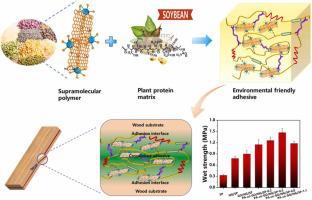Industrial Crops and Products ( IF 5.6 ) Pub Date : 2023-05-25 , DOI: 10.1016/j.indcrop.2023.116919 Shicun Jin , Jieping Xing , Tao Liu , Kuang Li , Fudong Zhang , Jinfeng Cao , Sheldon Q. Shi , Jianzhang Li

|
The introduction of 2D graphene into the soybean protein (SP) adhesive is expected to enhance its mechanical performance. However, insufficient binding of the two materials inevitably leads to the resulting composite having limited mechanical strength. Using phytic acid (PA) and a supramolecular self-assembly strategy, hard graphene oxide (GO) was first assembled with PA to form a supramolecular polymer, PA-co-GO, that has a “bricks and mortar” structure as a result of strong non-covalent interactions. PA-co-GO was then further combined with SP in the presence of the long-chain epoxy compound neopentyl glycol diglycidyl ether (NG) to produce a novel biopolymer-based adhesive PA-co-GO/NG/SP. The prepared adhesive has a moisture-insensitive interface as a result of non-covalent/covalent bonds and a “bricks and mortar” microstructure that allows the dissipation of energy, resulting in an enhancement in the water-resistant bonding strength of the material, with a 345% increase in its wet bonding strength compared with the unmodified SP adhesive. Additionally, the combination of the heat shielding of the GO and catalytic carbonization of PA resulted in the adhesive having excellent flame retardant properties. The structure and morphology of the materials were characterized using atomic force microscopy (AFM), dynamic light scattering (DLS), Fourier-transform infrared (FTIR), X-ray photoelectron spectra (XPS), X-ray diffraction (XRD), scanning electron microscopy (SEM), Raman spectroscopy, and solid-state 13C NMR. Overall, a new clean route for preparing green high-performance biopolymer-based adhesives is described, with potential applications for sustainable agricultural byproducts.
中文翻译:

植酸插层氧化石墨烯的有机-无机结构单元用于增强植物源性粘合剂的性能
将二维石墨烯引入大豆蛋白 (SP) 粘合剂有望提高其机械性能。然而,两种材料的结合不充分不可避免地导致所得复合材料的机械强度有限。使用植酸 (PA) 和超分子自组装策略,首先将硬氧化石墨烯 (GO) 与 PA 组装形成超分子聚合物 PA-co-GO,由于强的非共价相互作用。然后,在长链环氧化合物新戊二醇二缩水甘油醚 (NG) 的存在下,PA-co-GO 进一步与 SP 结合,生成新型生物聚合物基粘合剂 PA-co-GO/NG/SP。所制备的粘合剂由于非共价键/共价键而具有对水分不敏感的界面和允许能量耗散的“砖和砂浆”微结构,从而提高材料的防水粘合强度,与与未改性的 SP 粘合剂相比,其湿粘合强度提高了 345%。此外,GO 的热屏蔽和 PA 的催化碳化相结合,使粘合剂具有优异的阻燃性能。利用原子力显微镜 (AFM)、动态光散射 (DLS)、傅里叶变换红外 (FTIR)、X 射线光电子能谱 (XPS)、X 射线衍射 (XRD)、扫描电子显微镜 (SEM)、拉曼光谱和固态 从而提高了材料的耐水粘合强度,与未改性的SP粘合剂相比,其湿粘合强度提高了345%。此外,GO 的热屏蔽和 PA 的催化碳化相结合,使粘合剂具有优异的阻燃性能。利用原子力显微镜 (AFM)、动态光散射 (DLS)、傅里叶变换红外 (FTIR)、X 射线光电子能谱 (XPS)、X 射线衍射 (XRD)、扫描电子显微镜 (SEM)、拉曼光谱和固态 从而提高了材料的耐水粘合强度,与未改性的SP粘合剂相比,其湿粘合强度提高了345%。此外,GO 的热屏蔽和 PA 的催化碳化相结合,使粘合剂具有优异的阻燃性能。利用原子力显微镜 (AFM)、动态光散射 (DLS)、傅里叶变换红外 (FTIR)、X 射线光电子能谱 (XPS)、X 射线衍射 (XRD)、扫描电子显微镜 (SEM)、拉曼光谱和固态 GO 的热屏蔽和 PA 的催化碳化相结合,使粘合剂具有优异的阻燃性能。利用原子力显微镜 (AFM)、动态光散射 (DLS)、傅里叶变换红外 (FTIR)、X 射线光电子能谱 (XPS)、X 射线衍射 (XRD)、扫描电子显微镜 (SEM)、拉曼光谱和固态 GO 的热屏蔽和 PA 的催化碳化相结合,使粘合剂具有优异的阻燃性能。利用原子力显微镜 (AFM)、动态光散射 (DLS)、傅里叶变换红外 (FTIR)、X 射线光电子能谱 (XPS)、X 射线衍射 (XRD)、扫描电子显微镜 (SEM)、拉曼光谱和固态13 C核磁共振。总的来说,描述了一种制备绿色高性能生物聚合物基粘合剂的新清洁途径,具有可持续农业副产品的潜在应用。









































 京公网安备 11010802027423号
京公网安备 11010802027423号